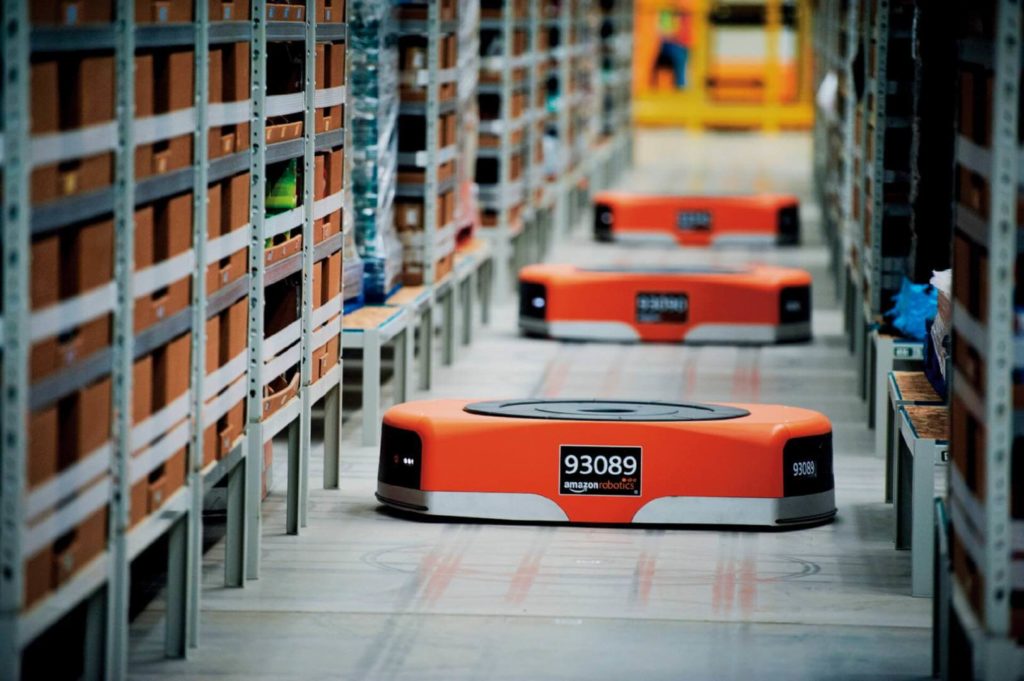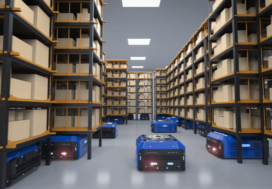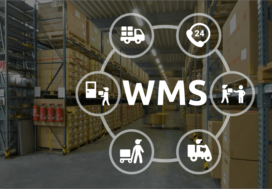
- What are AGVs: explained
- Types of AGVs: what warehouse robots can do
- Covariant case: how robots use AI for AGV-sorting
- How Ukrainian companies implement robotization in their warehouses
- Automatic guided carts in warehouses of Nova Poshta
- OMEGA provides AGV-sorting on its warehouses
- Conclusions
According to the statistics, labor costs in warehousing are about 65% of total operational expenses. Moreover, working at a warehouse requires high speed and hard physical activities. Some warehouses can process more than 10 000 stock-keeping units per day. On average, warehouse staff walks from 12 to 20 km between shelves for one working shift. It gets complicated to process orders quickly and correctly. So, human mistake rates can grow.
Large companies invest in warehouse automation to increase productivity and reduce the risks of errors. Such a trend has been actively developing since 2020 when eCommerce began to grow rapidly. The point is that the speed and picking of orders are critical for online retailers.
Robots working in Amazon’s warehouses are cases in point of how automation helps to increase warehousing productivity. They can perform a routine operation for 15 minutes, while a warehouse worker spends more than 1 hour to do it.
In our article, you’ll learn how robots help to improve the efficiency of a warehouse, what automation solutions are already available on the market. You’ll also explore how warehouse robotization works in Ukraine.
What are AGVs: explained
Warehousing logistics is a domain where innovations are actively implemented. To work in warehouses companies use robots, called AGVs.
The AGV stands for Automated Guided Vehicle. Based on the term meaning, such robots can work fully autonomously. So, there is no need for a driver or remote control tools to operate them. On-board sensors help robots to move through a warehouse and do routine operations.
Types of AGVs: what warehouse robots can do
There are a lot of operations in warehouses. For example, personnel can pick items from store shelves, sort and pack products. One robot can’t assume all operations, so there are several types of AGVs for different work.

Warehouse robots are divided on:
- Automatic Guided Carts. They can move and place goods. Such robots are equipped with hoisters to bring an item from a storage locker. They can also place goods on pallets, transport them to the right place, and unload freights.
- Towing vehicles. They move hard carts with goods around a warehouse.
- Unit Load Handlers. They are used to move one unit or pallet with multiple items.
- Sorting Robots. They sort and pack goods. Some of them can monitor information about several products at once. Sorting robots are common AGVs for eCommerce, where workers process items by pieces.
- Drones. They help with inventory count in warehousing.
Enterprises use several types of AGVs at once, so they can significantly simplify working in their warehouses. For example, Unit Load Handlers deliver pallets to a picking area, where sorting robots do operations, etc.
Covariant case: how robots use AI for AGV-sorting
Nowadays, there are a lot of startups that develop warehouse robots. Covariant is one of them. In 2018, Knapp, a leading warehouse automation solutions provider, appealed to the team to develop a robotic arm for sorting.
Other companies tried to implement the project for more than 6 years. But the issue is that the robotic arm must be able to handle different types of items, such as packets of pills, for example.
To deliver the solution, Covariant has implemented AI technologies the robotic arm could study by itself.
The robot’s algorithms analyze the position of an object in space, calculate what angle is better to take an item, and adapt the sequence of movements for each operation. A human managed the robotic arm for the first time to start the studying process. The system created flowcharts and decision points after every operation. Moreover, the robotic arm tried to sort more than 1.000 different items independently. Then, the system was analyzing successes and failures.
Artificial intelligence technologies are in great demand for the warehousing industry. For example, Škoda corporation even developed AI-solution to load containers with minimal losses. Just read our article to know more about it.
How Ukrainian companies implement robotization in their warehouses
Warehouse innovations are associated with Amazon. However, Ukrainian companies also automate their storage facilities, where robots work with warehouse personnel side by side.
Automatic guided carts in warehouses of Nova Poshta
In 2020, the large Ukrainian postal operator Nova Poshta began to use robots on its logistics complexes in Lviv. The company has bought automatic guided carts from SB Robotics, the Ukrainian robotization solutions provider.
At first, the postal operator just tested warehouse robots but then started to use them on an ongoing basis. The company is going to use 20 automatic guided carts in its innovative sorting terminal.

The automatic guided carts move goods from the unloading to the loading area. As Nova Poshta announced, robots can speed 0.8 meters per second. They can carry more up to 300 kilos and take in tow up to 1.000 kilos.
OMEGA provides AGV-sorting on its warehouses
In October 2020, a large Ukrainian car parts distributor OMEGA announced a collaboration with KAPELOU, the manufacturer of warehouse equipment. Now they are working on an AGV-sorting implementation project.
According to KAPELOU, at the moment OMEGA’s warehouses process more than 16 000 SKUs per day. The major assortment is pedlar products that warehouse workers sort manually. Moreover, delivery speed is critical for OMEGA. The distributor implements AGV-sorting to speedy order processing. It’s the first such project in Ukraine.

Sorting-robots by KAPELOU can process more than 8 000 load units per hour, and move even small items weighing up to 5 kilos. AGVs are battery-operated. The batteries power the robots for up to 4 hours of working time.
OMEGA has already implemented software integration. And now the company is going to test shuttle boxes.
Conclusions
Large enterprises invest in warehouse automation. Companies’ experience shows robotization is a great solution to decrease labor cost expenses, speedy warehouse order processing, and minimize the risks.
Warehousing logistics uses AGVs. Such robots have extended functionality. They move goods around warehouses, pick, sort, and pack products.
Robotization is rapidly growing in the USA. For example, Covariant, an American startup developed the AI robotic arm to sort fragile items. Artificial intelligence helps the arm to study by itself.
In 2020, Ukrainian companies also implemented warehouse robotization. So, the large postal operator Nova Poshta has bought automatic guided carts. And the national auto parts distributor OMEGA has been implementing AGV-sorting in its warehouses.




